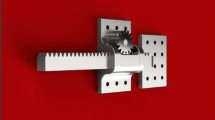Abstract
Objective
Cranial vault remodeling surgery for craniosynostosis carries the potential risk of dural venous sinus injury given the extensive bony exposure. Identification of the dural venous sinuses can be challenging in patients with craniosynostosis given the lack of accurate surface-localizing landmarks. Computer-aided design and manufacturing (CAD/CAM) has allowed surgeons to pre-operatively plan these complex procedures in an effort to increase reconstructive efficiency. An added benefit of this technology is the ability to intraoperatively map the dural venous sinuses based on pre-operative imaging. We utilized CAD/CAM technology to intraoperatively map the dural venous sinuses for patients undergoing reconstructive surgery for craniosynostosis in an effort to prevent sinus injury, increase operative efficiency, and enhance patient safety. Here, we describe our experience utilizing this intraoperative technology in pediatric patients with craniosynostosis.
Methods
We retrospectively reviewed the charts of children undergoing reconstructive surgery for craniosynostosis using CAD/CAM surgical planning guides at our institution between 2012 and 2016. Data collected included the following: age, gender, type of craniosynostosis, estimated blood loss, sagittal sinus deviation from the sagittal suture, peri-operative outcomes, and hospital length of stay.
Results
Thirty-two patients underwent reconstructive cranial surgery for craniosynostosis, with a median age of 11 months (range, 7–160). Types of synostosis included metopic (6), unicoronal (6), sagittal (15), lambdoid (1), and multiple suture (4). Sagittal sinus deviation from the sagittal suture was maximal in unicoronal synostosis patients (10.2 ± 0.9 mm). All patients tolerated surgery well, and there were no occurrences of sagittal sinus, transverse sinus, or torcular injury.
Conclusions
The use of CAD/CAM technology allows for accurate intraoperative dural venous sinus localization during reconstructive surgery for craniosynostosis and enhances operative efficiency and surgeon confidence while minimizing the risk of patient morbidity.




Similar content being viewed by others
References
Burge J, Saber NR, Looi T, French B, Usmani Z, Anooshiravani N, Kim P, Forrest C, Phillips J (2011) Application of CAD/CAM prefabricated age-matched templates in cranio-orbital remodeling in craniosynostosis. J Craniofac Surg 22:1810–1813. https://doi.org/10.1097/SCS.0b013e31822e8045
Dorafshar A, Fisher M, Borsuk D, Fishman E, Ahn E (2014) A novel application of computer-aided design and manufacturing for reduction cranioplasty. J Craniofac Surg 25:172–176. https://doi.org/10.1097/SCS.0000000000000385
Esparza J, Hinojosa J, Garcia-Recuero I, Romance A, Pascual B, Martinez de Aragon A (2008) Surgical treatment of isolated and syndromic craniosynostosis. Results and complications in 283 consecutive cases. Neurocirugia (Astur) 19:509–529
Fisher M, Medina M 3rd, Bojovic B, Ahn E, Dorafshar AH (2016) Indications for computer-aided design and manufacturing in congenital craniofacial reconstruction. Craniomaxillofac Trauma Reconstr 9:235–241. https://doi.org/10.1055/s-0036-1584391
Goodrich JT (2004) Craniofacial surgery: complications and their prevention. Semin Pediatr Neurol 11:288–300
Greensmith AL, Holmes AD, Lo P, Maxiner W, Heggie AA, Meara JG (2008) Complete correction of severe scaphocephaly: the Melbourne method of total vault remodeling. Plast Reconstr Surg 121:1300–1310. https://doi.org/10.1097/01.prs.0000304592.56498.d6
Greives MR, Ware BW, Tian AG, Taylor JA, Pollack IF, Losee JE (2016) Complications in posterior cranial vault distraction. Ann Plast Surg 76:211–215. https://doi.org/10.1097/SAP.0000000000000518
Mardini S, Alsubaie S, Cayci C, Chim H, Wetjen N (2014) Three-dimensional preoperative virtual planning and template use for surgical correction of craniosynostosis. J Plast Reconstr Aesthet Surg 67:336–343. https://doi.org/10.1016/j.bjps.2013.11.004
Mommaerts MY, Jans G, Vander Sloten J, Staels PF, Van der Perre G, Gobin R (2001) On the assets of CAD planning for craniosynostosis surgery. J Craniofac Surg 12:547–554
Protzenko Cervante T, Arnaud E, Brunelle F, Di Rocco F (2016) Unilateral coronal synostosis: can we trust the sagittal suture as a landmark for the underlying superior sagittal sinus? J Neurosurg Pediatr 17:589–594. https://doi.org/10.3171/2015.8.PEDS15117
Reis CV, Gusmao SN, Elhadi AM, Dru A, Tazinaffo U, Zabramski JM, Spetzler RF, Preul MC (2015) Midline as a landmark for the position of the superior sagittal sinus on the cranial vault: an anatomical and imaging study. Surg Neurol Int 6:121. https://doi.org/10.4103/2152-7806.161241
Russell AJ, Patel KB, Skolnick G, Woo AS, Smyth MD (2014) The path of the superior sagittal sinus in unicoronal synostosis. Childs Nerv Syst 30:1701–1709. https://doi.org/10.1007/s00381-014-2384-9
Seruya M, Borsuk DE, Khalifian S, Carson BS, Dalesio NM, Dorafshar AH (2013) Computer-aided design and manufacturing in craniosynostosis surgery. J Craniofac Surg 24:1100–1105. https://doi.org/10.1097/SCS.0b013e31828b7021
Stricker PA, Goobie SM, Cladis FP, Haberkern CM, Meier PM, Reddy SK, Nguyen TT, Cai L, Polansky M, Szmuk P, Fiadjoe J, Soneru C, Falcon R, Petersen T, Kowalczyk-Derderian C, Dalesio N, Budac S, Groenewald N, Rubens D, Thompson D, Watts R, Gentry K, Ivanova I, Hetmaniuk M, Hsieh V, Collins M, Wong K, Binstock W, Reid R, Poteet-Schwartz K, Gries H, Hall R, Koh J, Bannister C, Sung W, Jain R, Fernandez A, Tuite GF, Ruas E, Drozhinin O, Tetreault L, Muldowney B, Ricketts K, Fernandez P, Sohn L, Hajduk J, Taicher B, Burkhart J, Wright A, Kugler J, Barajas-DeLoa L, Gangadharan M, Busso V, Stallworth K, Staudt S, Labovsky KL, Glover CD, Huang H, Karlberg-Hippard H, Capehart S, Streckfus C, Nguyen KT, Manyang P, Martinez JL, Hansen JK, Levy HM, Brzenski A, Chiao F, Ingelmo P, Mujallid R, Olutoye OA, Syed T, Benzon H, Bosenberg A, Pediatric Craniofacial Collaborative G (2017) Perioperative outcomes and Management in Pediatric Complex Cranial Vault Reconstruction: a multicenter study from the pediatric craniofacial collaborative group. Anesthesiology 126:276–287. https://doi.org/10.1097/ALN.0000000000001481
Taylor JA, Derderian CA, Bartlett SP, Fiadjoe JE, Sussman EM, Stricker PA (2012) Perioperative morbidity in posterior cranial vault expansion: distraction osteogenesis versus conventional osteotomy. Plast Reconstr Surg 129:674e–680e. https://doi.org/10.1097/PRS.0b013e3182443164
Tubbs RS, Salter G, Elton S, Grabb PA, Oakes WJ (2001) Sagittal suture as an external landmark for the superior sagittal sinus. J Neurosurg 94:985–987. https://doi.org/10.3171/jns.2001.94.6.0985
Funding
None.
Author information
Authors and Affiliations
Corresponding author
Ethics declarations
Conflict of interest
The authors report no conflict of interest concerning the materials or methods used in this study or the findings specified in this paper.
Rights and permissions
About this article
Cite this article
Iyer, R.R., Wu, A., Macmillan, A. et al. Use of computer-assisted design and manufacturing to localize dural venous sinuses during reconstructive surgery for craniosynostosis. Childs Nerv Syst 34, 137–142 (2018). https://doi.org/10.1007/s00381-017-3601-0
Received:
Accepted:
Published:
Issue Date:
DOI: https://doi.org/10.1007/s00381-017-3601-0




